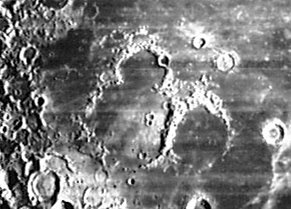Struve
Contents
Struve
|
Lat: 22.4°N, Long: 77.1°W, Diam: 164 km, Depth: 2.29 km, Rükl: 17 |
Images
LPOD Photo Gallery Lunar Orbiter Images
- Zond 7 (Struve and environs, local evening light).
- The Hi-Res scan of Lunar Orbiter 4's photograph LOIV-182-h3 probably shows the Concentric Crater on the floor of Struve (number 47 in C.A.Wood's list of 1978). This Concentric Crater is perhaps the one immediately "above" the disturbing blur near the frame's lower right corner. See: LOIV-182-h3.
Research: Danny Caes
Maps
(LAC zone 37C1) USGS Digital Atlas PDF
Description
Description: Elger
(IAU Directions) OTTO STRUVE.--An enormous enclosure, bounded on the W. by the Hercynian Mountains, and on the E. by a mountain chain of considerable altitude, surmounted by three or more bright little rings. On the E. side of the uneven-toned interior, which, according to Madler, includes an area of more than 26,000 square miles, stand four craters, several little hills, and light spots. On the E. is the much more regular and almost as large formation, Otto Struve A, the E. border of Otto Struve forming its W. wall. This enclosure is bounded elsewhere by a very low, broken, and attenuated barrier. At sunrise the W. and E. walls, with the mountain mass at the N. end, which they join, resemble a pair of partially-opened calipers. There is one conspicuous little crater on the E. side of the floor; and, at or near full moon, four or five white spots, nearly central, are prominently visible.
Description: Wikipedia
Additional Information
Depth data from Kurt Fisher database
- Westfall, 2000: 2.29 km
- Cherrington, 1969: 1.7 km
Concentric Crater on the floor of Struve, at 22° North/ 77.7° West (included as item number 47 in C.A.Wood's list of Concentric Craters, published in 1978).- DannyCaes Nov 1, 2009
Nomenclature
- Friedrich Georg Wilhelm von Struve (April 15, 1793 – November 23, 1864) was a Baltic-German astronomer from a famous dynasty of astronomers. Struve's name is best known for his observations of double stars. Although double stars had been studied earlier, Struve outdid any previous efforts. He discovered a very large number of double stars and in 1827 published his double star catalogue Catalogus novus stellarum duplicium.
- Otto Wilhelm von Struve (May 7, 1819 – April 14, 1905) was a Russian astronomer of German ethnic origin. He was the son of Friedrich Georg Wilhelm von Struve and the grandfather of Otto Struve. He worked as his father's assistant and succeeded him as director of Pulkovo Observatory (until 1889). He continued his father's work in discovering double stars. He also observed satellites of Uranus and Neptune, and measured the rings of Saturn.
- Otto Struve (August 12, 1897 – April 6, 1963) was a Russian-American astronomer. He succeeded Frost as director of Yerkes Observatory. He also served as president of the International Astronomical Union.
- As indicated, this crater now honors three generations of a family of famous astronomers. However, in the original 1935 IAU Nomenclature of Blagg and Müller (as in Elger), this feature was known as "O. Struve", presumbably a reference to O. W. Struve. In Blagg and Müller, the name "Struve" (without an initial -- presumably a reference to F. G. W. Struve) meant a feature near the NE limb, probably the same as that now know as Lacus Spei. - Jim Mosher
- It is possible that Struve H was called Armenter by Wilkins and Paluzie-Borrell, but the I.A.U. did not accept that name.
- Armenter (Frederic Armenter De Monasterio) was a Spanish solar physicist.
LPOD Articles
Bibliography
A Portfolio of Lunar Drawings (Harold Hill), pages 78, 79.
-"Armenter" (probably Struve H):
THE MOON by H.P.Wilkins and P.Moore.
Wilhelm Struve in the Sourcebook Project (William R. Corliss)
- In Mysterious Universe, a handbook of astronomical anomalies (1979) :
- Page 576: A Peculiar Telescopic Phenomenon (Peter Doig, Journal of the British Astronomical Association, 1930).
Otto Struve in the Sourcebook Project (William R. Corliss)
- In Mysterious Universe, a handbook of astronomical anomalies (1979) :
- Pages 578-579: Mass-Luminosity Discordances (Dorrit Hoffleit, Sky and Telescope, 1949).
Note: on January the 27th of 1822, a certain Struve observed some sort of luminescence in the vicinity of crater Aristarchus, see page 238 in Mysterious Universe, a handbook of astronomical anomalies (W.R.Corliss, The Sourcebook Project, 1979), in the article Lunar Luminescence (E.J.Flamm, Nature, 1965).
